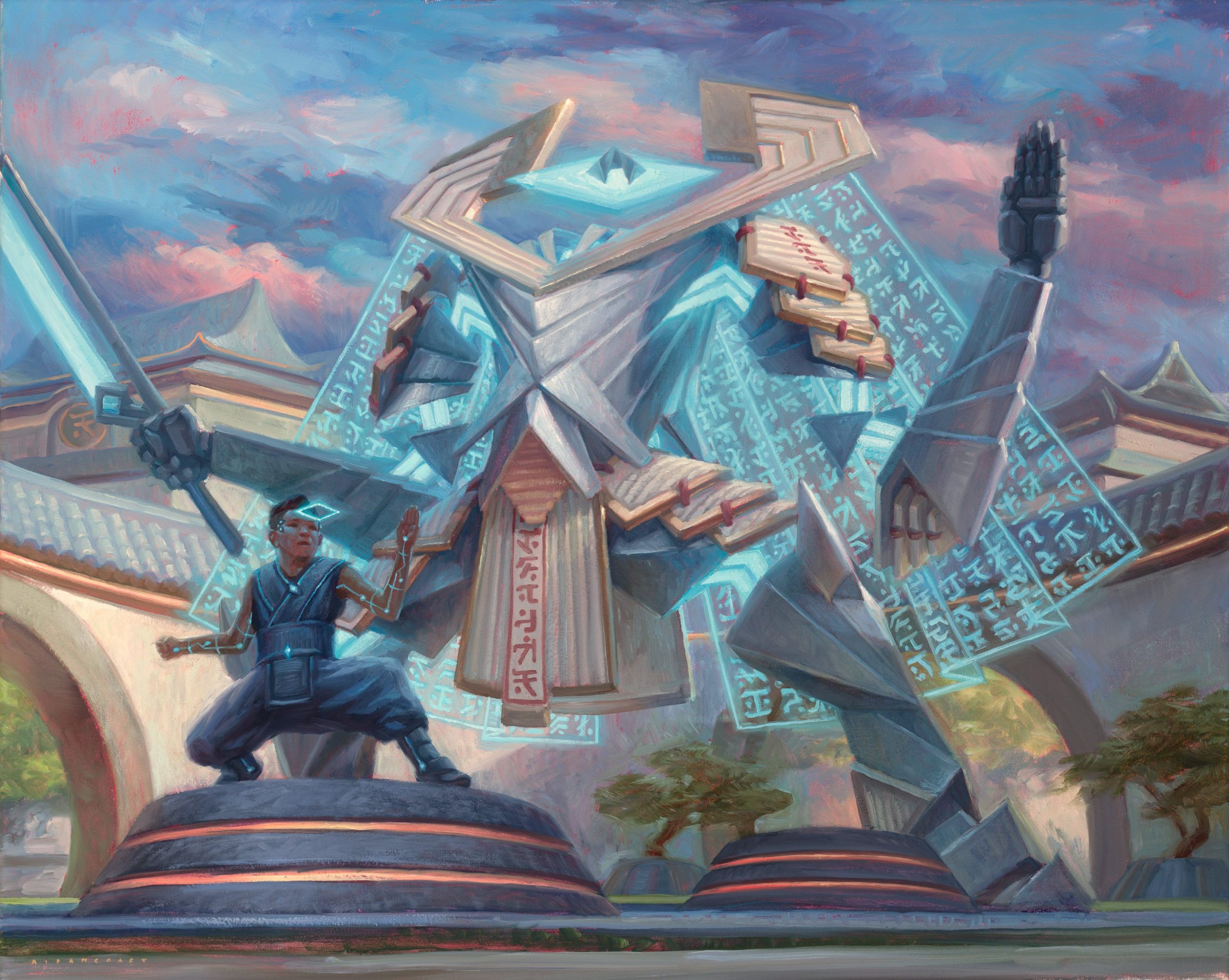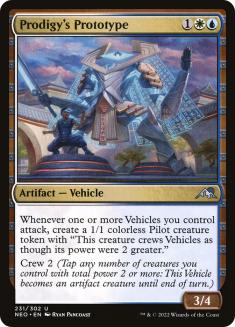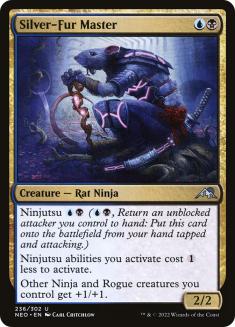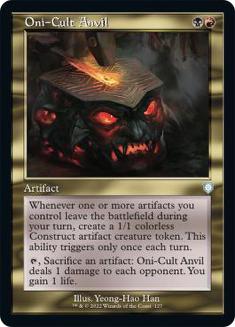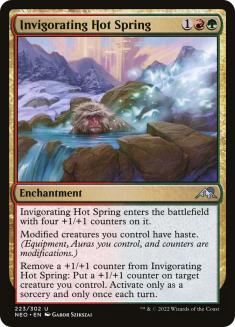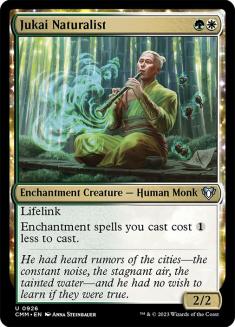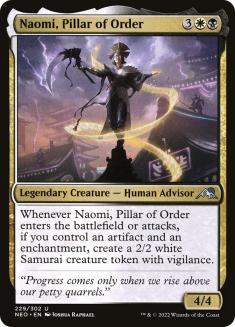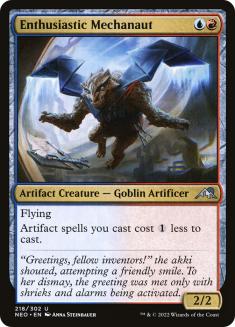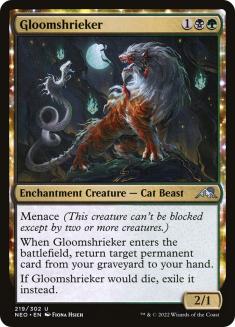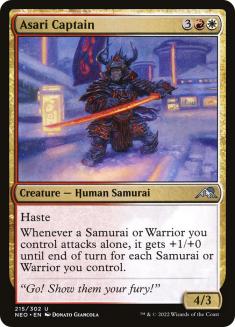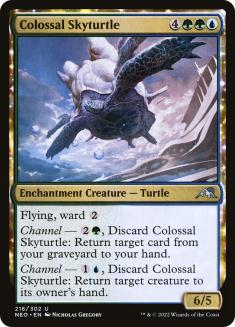Next week we get to get our hands dirty with the new Limited set: Kamigawa: Neon Dynasty. While it’s impossible to know how the set will play out just yet, it’s still useful to take a look at the mechanics in an attempt to discern information about the format such as speed and color balance. One of the best ways to get a glimpse into how mechanics affect a format is the structure of archetypes. So, let’s take a look at all ten:
Azorius: Vehicles
Azorius is historically an archetype filled with flyers, and it’s unclear whether or not that will be the case in this format. It’s certainly possible that Vehicles lend themselves well to playing flyers, but that’s not guaranteed. I’d expect this deck to be relatively aggressive, as Vehicles tend to be best when they’re granting creatures pseudo-haste.
Dimir: Ninjutsu
Ninjutsu is a fan-favorite mechanic that allows you to swap unblocked attackers with Ninjas in your hand. Ninjas often function like Ophidian, with a triggered ability when they deal combat damage to an opponent. Black or blue creatures that are cheap and evasive will be highly sought-after in this archetype, and may just be generic high picks in this format to enable monocolored Ninjas in 70% of the supported archetypes. Note that these types of decks are generally aggressive, but not focused on speed.
Rakdos: Artifact Sacrifice
Rakdos is often a sacrifice deck, and it’s no different in this format. However, Kamigawa: Neon Dynasty provides an extra nuance to Rakdos: artifact synergy. It’s unclear how important the artifacts will be to this deck, but I imagine that theme will help this deck be more than just aggressive. So far, all three archetypes are leaning aggressively.
Gruul: Modified
Equipment, Auras you control, and counters are “modifications.” Hence a modified creature is one that has any of the described “modifications.” Because of this, Gruul is about “going tall.” Modify some threats and hit hard!
Selesnya: Enchantments Matter
“Enchantments Matter” usually ends up being a value deck, trying to play enchantments that draw extra cards. Enchantment creatures make it a bit easier than it used to be, but it’s still a relatively parasitic archetype. Depending on the density of Auras, it can also be quite aggressive, but that’s not the default speed of an archetype like this.
Orzhov: Artifacts and Enchantments
We have, quite literally, never seen an archetype like this before. I have absolutely no clue what to expect. It could be really cool, but I have a sneaking suspicion that Orzhov will just end up being a normal midrange deck without much of a theme. It seems really hard to pull off a deck based on the synergy of two separate card types.
Izzet: Artifacts Matter
“Artifacts Matter” is a tried-and-true archetype, and often one of the more powerful strategies when it’s offered. Like most Limited archetypes, this one can range from very fast to very slow depending on the supporting cast. Still, it’s one to keep an eye on because the artifact theme is one of the biggest themes in the set. We’ve already covered five archetypes where artifacts matter, and this is the one most likely to have the biggest punch on that particular synergy.
Golgari: Recursion
Golgari is often some graveyard recursion deck, and it’s the exact same here. I should note that this is the first archetype covered so far that really can’t be aggressive. Not that this means the format will be fast, but it’s something to keep an eye on.
Boros: Warriors/Samurai
Boros is, as always, an aggressive deck. But this has an interesting twist reminiscent of exalted. With Boros and Gruul both being aggressive decks focused on single threats rather than creating a wide battlefield, there’s going to be an interesting tension surrounding one-for-one removal. On the one hand, removing a threat the opponent has invested a lot into is great. On the other hand, reconfigure means that you’re more often trading down with that removal spell.
Simic: Channel Ramp
There’s always a green ramp deck, and it’s most commonly Simic, so no surprise here. Channel, however, is an interesting descriptor. Effectively this means “creatures can often be cast as instants instead,” which is an interesting dynamic for a ramp deck. I expect this archetype to hence have a pretty high creature density, which again may make it play out a bit faster than Simic ramp usually does because there is a higher probability it can assume the role of the beatdown.
Okay, so now that we have a general picture of archetypes, what speculations seem reasonable?
- The format is more likely to be fast than it is to be slow.
- Artifacts are a more important card type than enchantments.
- There’s a lot of explicit tension around how you spend your mana.
The first two points are straightforward and don’t need much explaining. Draft artifacts. Keep your deck lean. Focus on two-drops. But mana expenditure, and the expectation of using mana in this format, are important to acknowledge and dissect. Why do I think that? Well, let’s take a look at the main mechanics:
Reconfigure
Creatures can become Equipment. Limited decks only have so many (usually 23) slots. Usually most of these slots are dedicated to creatures and removal. This means that it’s hard to play multiple Equipment because it can be difficult to fit alongside enough of a strong creature supporting cast. Further, Equipment is a natural mana sink. By having a density of common creatures that become Equipment, this yields a format in which decks naturally have a variety of ways to spend large chunks of mana.
Ninjutsu
While Ninjutsu is an aggressive mechanic that asks you to be attacking, it doesn’t leave you in topdeck mode. Cards like Moon-Circuit Hacker keep the spells flowing, and using ninjutsu puts another spell in your hand to cast later. You can even do some pretty crazy tricks at the end of combat to continually swap Ninjas and ensure your best one continues to go unblocked. Like Equipment creatures, this is another mechanic that puts tension on the combat step while providing many uses for your mana.
Channel
Unlike ninjutsu and reconfigure, channel doesn’t give you opportunities to spend mana more than once. However, it does provide inherent modality, often at different mana costs. If a card in your hand can be cast for either three or five mana, the probability you have the opportunity to maximize the mana you spend each turn is increased. So, while channel doesn’t necessarily give use to excess lands, it still means turns in this format are more likely to be high-impact. The heuristic of “spend all your mana every turn” is a tried-and-true one, and this format looks like it’s designed to give you as many options as possible to do just that.
Given all of this, my main takeaway, which I find very exciting, is that this format will be tense. Not necessarily fast, but tense. Games won’t be over in a blink of an eye like Amonkhet, Zendikar, or Gatecrash. But there is such a high potential for a lot to happen each turn that the games will feel tense, and generally maintain a brisk pace. To succeed in this format, drafting decks that can spend mana every turn will be key. Sierkovitz has shown this correlation is maintained in the data of prior formats, and I expect it to be even more exacerbated in Kamigawa: Neon Dynasty Limited.

